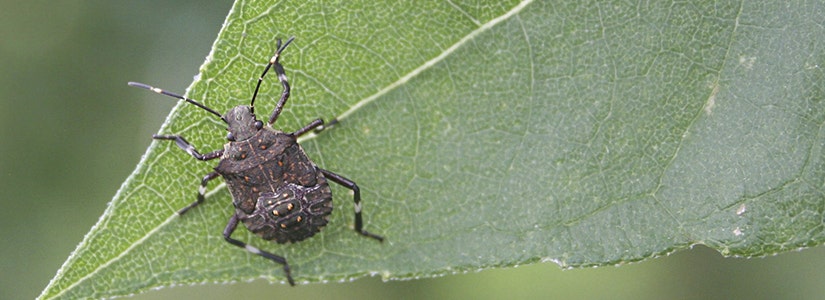

- Home
- Solution Center
- Learn
- Outdoor Pests
- Brown Mamorated Stink Bugs: The Truth Stinks
Brown Mamorated Stink Bugs: The Truth Stinks
What's brown, smelly and sucks on plants? Brown Marmorated Stink Bugs (BMSBs). And what attracts Stink Bugs in your house? Like Boxelder Bugs and Asian Ladybird Beetles, these insects gather by the hundreds in fall on the exterior walls of homes, working their way indoors in search of winter shelter. And if you squash them, especially indoors, you’ll find out why they got the name Stink Bugs. Here answers to your questions about this stinky pest –from what Stink Bugs look like to new ways to keep Stink Bugs away.
What are Stink Bugs and how did they get here?
BMSBs are an invasive species of true bugs sometimes called Shield Bug. Native to Asia, they were first identified on U.S. soil in 2001. Allentown, Pa., is ground zero for the U.S. invasion. BMSBs have been recorded in 40 states (including Hawaii) and Canada. Mid-Atlantic states host the most damaging populations.
Are there other Stink Bugs besides BMSBs in the United States?
More than 20 Stink Bug varieties make their homes within U.S. borders. Some, like the Florida Predatory Stink Bug or the Spined Soldier Bug, eat other insects. To help distinguish between these bugs, check out the Rutgers Cooperative Extension website to find great pictures of BMSBs.
How do Stink Bugs get around?
BMSTs are good travelers. Researchers have clocked these stinkers flying up to 1.2 miles per day. That's a strong flier in the insect world. Most often, they travel by riding the wind –or hitching a ride on tractor trailers or train cargo.
How often do Stink Bugs reproduce?
The insects only manage one generation per year on average in this country, but up to two generations in warmer regions. They also can achieve two generations in colder areas when warmer weather patterns prevail.
Where do Stink Bugs lay their eggs?
Females usually lay their eggs in summer on the undersides of leaves. The eggs are white to light green and are laid in tight clusters of 20 to 30.
What do Brown Marmorated Stink bugs eat?
BMSTs feed on a large variety of plants, using their piercing mouthpieces to suck juices from leaves and fruit. Their feeding leaves a characteristic cat-faced scarring. What attracts stink bugs? Brown Marmorated Stink Bugs are especially attracted to Eastern redbud, butterfly bush, mimosa, holly, fruit trees (apple, pear, crabapple, etc.), maple, and magnolia. In a typical home garden setting, they like corn, sunflowers, tomatoes, peppers and berry crops.
How do you control Stink Bugs? In the battle against BMSBs, researchers have several discovered several biocontrol options. Entomologists have discovered that Native Parasitic Wasps are attacking BMSB eggs. Researchers are also studying the potential of Asian Parasitic Wasps –in quarantine –from the BMSB's native habitat.
New studies show that BMSBs winter in large (more than 24 inches in circumference), dead standing trees with peeling bark, especially oak and locust. Removing those trees on wooded lots can help reduce BMSB habitat in areas of intense infestation.
A great resource is StopBMSB.org, funded by the USDA. Your local Cooperative Extension System office can provide information specifically for your area. Link to our other story? https://www.bioadvanced.com/articles/controlling-stink-bugs
While BMSBs have no natural U.S. predators, entomologists have witnessed Spiders, Praying Mantises, Wheel Bugs and Assassin Bugs consuming the insects. Black-capped chickadees, chickens and guinea fowl also feast on BMSBs. Some cats eat the stinkers, and most skunks do, too.
What keeps Stink Bugs away?
There are a host of things you can do to deal with Stink Bugs.
- Apply an insecticide as a perimeter treatment to help prevent these insects from moving into your home.
- The U.S. Department of Agriculture (USDA) Agricultural Research Service has identified a pheromone that's being used in traps to attract Stink Bugs. Light-based traps also lure BMSBs. Research any trap before investing cash. Follow trap directions carefully for best results.













